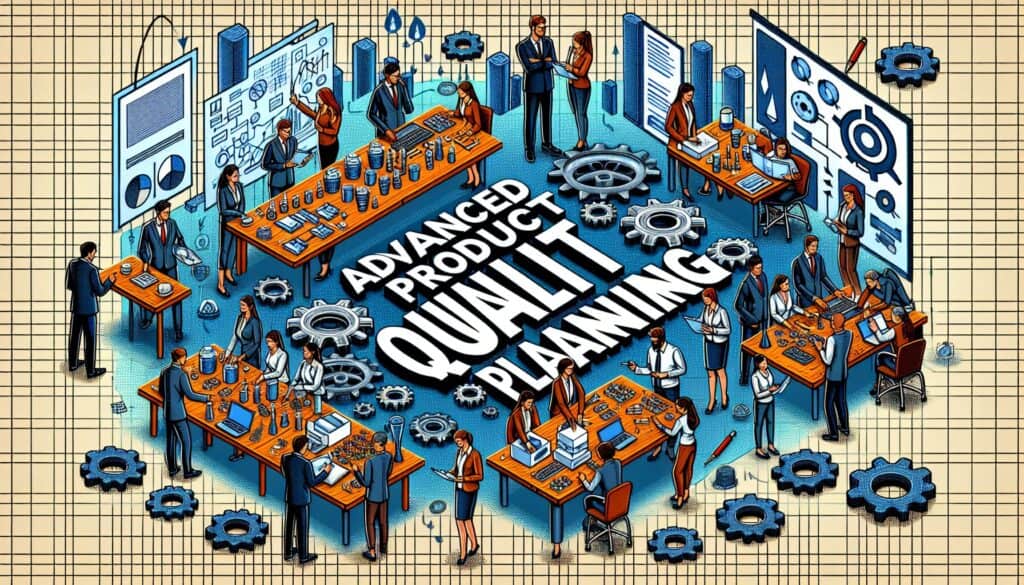A structured process that defines and establishes the steps necessary to ensure that a product satisfies the customer’s requirements and expectations, on time and at an acceptable cost.
- المنهجيات: الأفكار, حل المشكلات
التخطيط المتقدم لجودة المنتج (APQP)

التخطيط المتقدم لجودة المنتج (APQP)
- التخطيط المتقدم لجودة المنتج (APQP), تحسين العمليات, تطوير المنتجات, إدارة دورة حياة المنتج, ضمان الجودة, مراقبة الجودة, إدارة الجودة, نظام إدارة الجودة (QMS), إدارة المخاطر
الهدف:
كيفية استخدامه:
- A cross-functional team follows a phased approach (typically 5 phases: Plan & Define; Product Design & Development; Process Design & Development; Product & Process Validation; Feedback, Assessment & Corrective Action) using various quality tools to develop and launch new products or processes.
الايجابيات
- Ensures early identification and mitigation of risks; Promotes collaboration between suppliers and customers; Leads to smoother product launches with fewer problems; Focuses on meeting customer requirements throughout the product lifecycle.
سلبيات
- Can be a lengthy and document-intensive process; Requires significant upfront planning and resources; Effectiveness depends on active participation from all stakeholders and strong project management.
الفئات:
- تصنيع, تصميم المنتج, إدارة المشاريع, الجودة, إدارة المخاطر
الأفضل لـ
- Developing and launching new products or making significant changes to existing products/processes, particularly in the automotive and other manufacturing industries, to ensure quality and customer satisfaction.
Advanced Product Quality Planning (APQP) is particularly beneficial in industries where product reliability and compliance with safety standards are paramount, such as automotive manufacturing, aerospace, electronics, and medical devices. As teams embark on this structured framework, they can effectively incorporate various quality tools such as Failure Mode and Effects Analysis (FMEA), مراجعات التصميم, and Control Plans at each phase, which ensures that potential issues are addressed well before reaching the consumer market. Companies like Ford, General Motors, and تويوتا have successfully implemented APQP to not only enhance their product development cycles but also to strengthen relationships with suppliers by involving them in early discussions, which leads to better integration of materials and processes. One of the key contexts for APQP is during the initial stages of a project, where cross-functional teams consisting of design engineers, quality assurance personnel, marketing representatives, and manufacturing experts converge to define project specifications. The involvement of diverse stakeholders fosters a comprehensive understanding of customer requirements and regulatory standards, ensuring that all voices are heard in the design and development phases. As product and process validation unfolds, rigorous testing and inspections occur, enabling organizations to verify product conformance against defined quality benchmarks. In the feedback phase, retrospective assessments are conducted, allowing teams to learn from the launch experience, capture lessons learned, and implement corrective actions for future projects. This holistic approach not only mitigates risks associated with product failures but also boosts customer satisfaction through improved product quality and reliability, thereby enhancing the overall brand reputation in competitive markets.
الخطوات الرئيسية لهذه المنهجية
- Identify customer needs and expectations.
- Develop product concepts and define preliminary requirements.
- Create detailed design and engineering specifications.
- Establish process flow and develop manufacturing plans.
- Conduct validation tests and reliability assessments.
- Implement feedback mechanisms for continuous improvement.
نصائح للمحترفين
- Integrate advanced simulation tools in the Design & Development phase to predict product performance and identify potential design flaws early.- Implement iterative feedback loops with robust metrics during Product & Process Validation to refine processes and align with evolving customer needs.- Utilize cross-functional workshops to enhance supplier collaboration, ensuring alignment on quality standards and expectations throughout the APQP phases.
لقراءة عدة منهجيات ومقارنتها, نوصي باستخدام
> مستودع المنهجيات الشامل <
مع أكثر من 400 منهجية أخرى.
نرحب بتعليقاتكم على هذه المنهجية أو المعلومات الإضافية على قسم التعليقات أدناه ↓، وكذلك أي أفكار أو روابط متعلقة بالهندسة.
منشورات ذات صلة
استبيانات الانزعاج العضلي الهيكلي
الاختبار متعدد المتغيرات (MVT)
تحليل الانحدار المتعدد
أنظمة التقاط الحركة
طريقة MoSCoW
اختبار متوسط المزاج